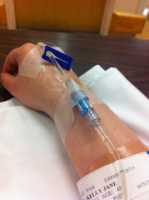Most Deaths From Sepsis Occur in Frail Older Adults and Are Not Preventable
Federal Incentives Did Not Reduce Catheter Infections in Hospitals
Steroids Associated With Reduced Mortality in Adults with Sepsis
Use of IV Fluids by EMTs Reduced Morality in Septic Patients With Low Blood Pressure
MedicalResearch.com Interview with: Daniel J. Lane PhD
Daniel J. Lane PhD
Institute of Health Policy, Management and Evaluation
Dalla Lana School of Public Health, University of Toronto
Rescu, Li Ka Shing Knowledge Institute, St Michael’s Hospital
Toronto, Ontario, Canada
MedicalResearch.com: What is the background for this study? What are the main findings?
Response: Early resuscitation and early antibiotics have become the mainstay treatment for patients with sepsis. The time to initiation of these treatments is thought to be an important factor in patients surviving their disease; however, the independent benefits or harms of intravenous fluid resuscitation, in particular a more aggressive versus more conservative approach to this therapy, remains difficult to evaluate given the concurrent use of these therapies in hospital.
To gain a better understanding of this treatment independent of antibiotic use, we assessed intravenous fluid resuscitation by paramedics on the in-hospital mortality of patients with sepsis. By accounting for the interaction between initial systolic blood pressure and the treatment, we found that earlier resuscitation by paramedics was associated with decreased mortality in patients with low initial blood pressures but not associated with mortality for patients with normal or higher initial blood pressures.
Even in Intensive Care, Health Care Costs Are Factor For Both Patients and Clinicians
Critical Illness: Haloperidol and Ziprasidone for Treatment of Delirium
No Benefit, More Complications with Hypothermia after Traumatic Brain Injury
Do Antipsychotics Shorten Duration of Delirium in ICU Patients?
Who is Really Sick? Eyeball Assessment vs Formal Triage
Critical Illness Linked To Brain Changes Associated with Cognitive Decline
Real World Treatment of Serious Infections with Ceftolozane/Tazobactam
Bezlotoxumab (Zinplava)For Prevention of Recurrent C. Difficile Infection
 Richard Hengel, MD, FRCPC, FACP
Atlanta ID Group
MedicalResearch.com: What is the background for this study? How does Bezlotoxumab differ from other medications for recurrent C. difficile infections?
Response: Clostridium difficile infection (CDI) is now the most common hospital acquired infection in the United States, accounting for significant morbidity and mortality, not only in the US, but around the world. Despite standard antibiotic therapy targeting the Clostridium difficile bacterium directly, recurrent infection is common, occurring in a quarter to a third of patients, often frail individuals with other concurrent medical problems. These patients can have multiple recurrences leading to their progressive deterioration over time. Until recently, the only treatment for CDI included antibiotics. More recently, fecal microbiota transplant is a promising, but as yet, FDA unapproved therapy. Bezlotoximab is a new FDA approved treatment for recurrent Clostridium difficile infection (rCDI) that compliments standard antibiotics. Bezlotoxumab is a monoclonal antibody targeting toxin B produced by Clostridium difficile during CDI. In two large treatment trials, bezotoxumab, in addition to standard-of-care antibiotics, reduced the frequency of CDI recurrences from about 28% to about 18%. In this study, we set out to see if this new drug performed as well in actual clinical practice as it did in the published clinical trials.
(more…)
Richard Hengel, MD, FRCPC, FACP
Atlanta ID Group
MedicalResearch.com: What is the background for this study? How does Bezlotoxumab differ from other medications for recurrent C. difficile infections?
Response: Clostridium difficile infection (CDI) is now the most common hospital acquired infection in the United States, accounting for significant morbidity and mortality, not only in the US, but around the world. Despite standard antibiotic therapy targeting the Clostridium difficile bacterium directly, recurrent infection is common, occurring in a quarter to a third of patients, often frail individuals with other concurrent medical problems. These patients can have multiple recurrences leading to their progressive deterioration over time. Until recently, the only treatment for CDI included antibiotics. More recently, fecal microbiota transplant is a promising, but as yet, FDA unapproved therapy. Bezlotoximab is a new FDA approved treatment for recurrent Clostridium difficile infection (rCDI) that compliments standard antibiotics. Bezlotoxumab is a monoclonal antibody targeting toxin B produced by Clostridium difficile during CDI. In two large treatment trials, bezotoxumab, in addition to standard-of-care antibiotics, reduced the frequency of CDI recurrences from about 28% to about 18%. In this study, we set out to see if this new drug performed as well in actual clinical practice as it did in the published clinical trials.
(more…)New Antibiotic Combination IMI/REL Can Treat Resistant Infection With Less Kidney Toxicity
NEJM: Rivaroxaban (XARELTO®) For Thromboembolism Prevention after Medical Illness
When Should Children in Pediatric Intensive Care Receive Parenteral Nutrition?
First Trial Compares Treatment Options For Serious Infections Caused by ESBL-Producers
Active Shooter Incidents Involving Semi-automatic Rifles More Deadly
Does Routine Oxygen After Heart Attack Reduce Risk of Dying?
Daily Chest X-Rays Still Overused in Mechanically Ventilated Patients
Leg cycling and electrical muscle stimulation for the critically ill? Still many peaks to climb up
 Guillaume Fossat, Physiotherapist and
Thierry Boulain, M.D.
Médecine Intensive Réanimation
Centre Hospitalier Régional
Orléans, France
MedicalResearch.com: What is the background for this study?
Response: Critically ill patients may suffer terrific muscle wasting during their intensive care unit stay. In most patients, particularly those with sepsis or other high inflammatory states, this is due to proteolytic pathways runaway that may persist as long as the cause of inflammation has not been eliminated. What is more, forced rest, as the one imposed to severely ill patients who need sedation to tolerate artificial respiratory support also induces muscle deconditioning and mass loss. In short, the more you are severely and acutely ill, the more you breakdown your muscle proteins and use the catabolic byproducts to fuel the rest of your organism. As a result of this sort of autophagy, intensive care unit survivors may have lost tens of muscle mass kilograms at discharge, to the point that they have lost all or parts of their functional autonomy. The personal and social burden is considerable as muscle weakness may persist several years after hospital discharge.
In the 2000’s, physiotherapy and early rehabilitation during intensive care have emerged as a way to counteract the autophagic muscle wasting and help patients to speed up their return to functional autonomy. Therefore, a standardized early rehabilitation that consists in early muscle exercises, systematic lowering or interruption of sedative drugs dosages to allow prompt patient’s awaking, early transfer to chair and early first walk try, has become the standard of care. However, to what extent, when and how muscles should be exercised during the intensive care unit stay in order to optimize the positive effects of rehabilitation remains a nearly blank clinical research area.
In-bed leg cycling and electrical muscle stimulation, each for their part, have shown encouraging results. In our study, we sought to know if the very early combination of both could improve global muscle strength in survivors at intensive care unit discharge.
(more…)
Guillaume Fossat, Physiotherapist and
Thierry Boulain, M.D.
Médecine Intensive Réanimation
Centre Hospitalier Régional
Orléans, France
MedicalResearch.com: What is the background for this study?
Response: Critically ill patients may suffer terrific muscle wasting during their intensive care unit stay. In most patients, particularly those with sepsis or other high inflammatory states, this is due to proteolytic pathways runaway that may persist as long as the cause of inflammation has not been eliminated. What is more, forced rest, as the one imposed to severely ill patients who need sedation to tolerate artificial respiratory support also induces muscle deconditioning and mass loss. In short, the more you are severely and acutely ill, the more you breakdown your muscle proteins and use the catabolic byproducts to fuel the rest of your organism. As a result of this sort of autophagy, intensive care unit survivors may have lost tens of muscle mass kilograms at discharge, to the point that they have lost all or parts of their functional autonomy. The personal and social burden is considerable as muscle weakness may persist several years after hospital discharge.
In the 2000’s, physiotherapy and early rehabilitation during intensive care have emerged as a way to counteract the autophagic muscle wasting and help patients to speed up their return to functional autonomy. Therefore, a standardized early rehabilitation that consists in early muscle exercises, systematic lowering or interruption of sedative drugs dosages to allow prompt patient’s awaking, early transfer to chair and early first walk try, has become the standard of care. However, to what extent, when and how muscles should be exercised during the intensive care unit stay in order to optimize the positive effects of rehabilitation remains a nearly blank clinical research area.
In-bed leg cycling and electrical muscle stimulation, each for their part, have shown encouraging results. In our study, we sought to know if the very early combination of both could improve global muscle strength in survivors at intensive care unit discharge.
(more…)




















